This book will help policy makers, university students, and the general public understand how the National Environmental Policy Act (NEPA) is intended to work, and how it can be used to reduce greenhouse gas (GHG) emissions in order to combat global warming. Unlike all other books on NEPA, this book focuses on the global warming problem in terms of thermodynamics and entropy. It explains how NEPA can help combat global warming by operationalizing the “energy requirements and conservation potential” analysis requirement in the Council on Environmental Quality (CEQ) regulations, 40 CFR 1502.16 (a)(7), and it puts the past, present, and future of the NEPA statute, the CEQ regulations, and energy analysis requirements all in one easy to find, portable place. It will be an excellent resource for university students and teachers, policy analysts, and those members of the public that want to know all about the NEPA Process.
As a third edition, the book contains new analysis on the amended NEPA statute (2023) and revised CEQ regulations (2024), CEQ’s January 9, 2023 interim guidance on how to incorporate GHG emissions into NEPA documents, the social costs of carbon, the long-term strategy of the United States to get to net-zero GHG by 2050, assessing climate risk in NEPA reviews, and the link between energy requirements analysis required by 40 CFR 1502.16 (a) (7) and reduced GHG emissions.
